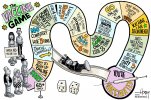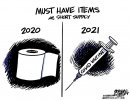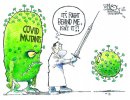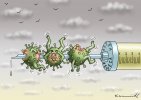Navigation
Install the app
How to install the app on iOS
Follow along with the video below to see how to install our site as a web app on your home screen.
Note: This feature may not be available in some browsers.
More options
Style variation
Guest viewing limit reached
- You have reached the maximum number of guest views allowed
- Please register below to remove this limitation
- Already a member? Click here to login
You are using an out of date browser. It may not display this or other websites correctly.
You should upgrade or use an alternative browser.
You should upgrade or use an alternative browser.
Can touching a barbell in the gym get you sick with the coronavirus?
- Thread starter Michael Scally MD
- Start date
[OA] COVID-19: Understanding Inter-Individual Variability and Implications for Precision Medicine
Article Highlights
The hallmark feature of COVID-19 that has confounded public perception and delivery of medical care for the disease is the wide variation observed in disease susceptibility and progression.
Innate biological differences in age, sex, race, the genome and differential immune responses of the person exposed to severe acute respiratory syndrome coronavirus 2 in addition to differences in the vral genome itself plays an important role in the inter-individual variability observed.
Predicting which patients are at risk for severe COVID-19 disease would enable delivery of the right care to the right patient.
Advances in data analytics, multi-omic and digital technologies, and the use of artificial intelligence may help the development of a precision medicine approach to the COVID-19 pandemic.
Coronavirus disease 2019 (COVID-19) is characterized by heterogeneity in susceptibility to the disease and severity of illness. Understanding inter-individual variation has important implications for not only allocation of resources but also targeting patients for escalation of care, inclusion in clinical trials, and individualized medical therapy including vaccination.
In addition to geographic location and social vulnerability, there are clear biological differences such as age, sex, race, presence of comorbidities, underlying genetic variation, and differential immune response that contribute to variability in disease manifestation. These differences may have implications for precision medicine.
Specific examples include the observation that androgens regulate the expression of the enzyme transmembrane protease, serine 2 which facilitates severe acute respiratory syndrome coronavirus 2 viral entry into the cell; therefore, androgen deprivation therapy is being explored as a treatment option in males infected with COVID-19.
An immunophenotyping study of COVID-19 patients has shown that a subset develop T cytopenia which has prompted a clinical trial that is testing the efficacy of interleukin-7 in these patients.
Predicting which COVID-19 patients will develop progressive disease that will require hospitalization has important implications for clinical trials that target outpatients. Enrollment of patients at low risk for progression of disease and hospitalization would likely not result in such therapy demonstrating efficacy.
There are efforts to use artificial intelligence to integrate digital data from smartwatch applications or digital monitoring systems and biological data to enable identification of the high risk COVID-19 patient. The ultimate goal of precision medicine using such modern technology is to recognize individual differences to improve health for all.
Pereira NL, Ahmad F, Byku M, Cummins NW, Morris AA, Owens A, Tuteja S, Cresci S. COVID-19: Understanding Inter-Individual Variability and Implications for Precision Medicine. Mayo Clin Proc. 2021 Feb;96(2):446-463. doi: 10.1016/j.mayocp.2020.11.024. Epub 2020 Dec 3. PMID: 33549263. https://www.mayoclinicproceedings.org/article/S0025-6196(20)31384-7/fulltext
Article Highlights
The hallmark feature of COVID-19 that has confounded public perception and delivery of medical care for the disease is the wide variation observed in disease susceptibility and progression.
Innate biological differences in age, sex, race, the genome and differential immune responses of the person exposed to severe acute respiratory syndrome coronavirus 2 in addition to differences in the vral genome itself plays an important role in the inter-individual variability observed.
Predicting which patients are at risk for severe COVID-19 disease would enable delivery of the right care to the right patient.
Advances in data analytics, multi-omic and digital technologies, and the use of artificial intelligence may help the development of a precision medicine approach to the COVID-19 pandemic.
Coronavirus disease 2019 (COVID-19) is characterized by heterogeneity in susceptibility to the disease and severity of illness. Understanding inter-individual variation has important implications for not only allocation of resources but also targeting patients for escalation of care, inclusion in clinical trials, and individualized medical therapy including vaccination.
In addition to geographic location and social vulnerability, there are clear biological differences such as age, sex, race, presence of comorbidities, underlying genetic variation, and differential immune response that contribute to variability in disease manifestation. These differences may have implications for precision medicine.
Specific examples include the observation that androgens regulate the expression of the enzyme transmembrane protease, serine 2 which facilitates severe acute respiratory syndrome coronavirus 2 viral entry into the cell; therefore, androgen deprivation therapy is being explored as a treatment option in males infected with COVID-19.
An immunophenotyping study of COVID-19 patients has shown that a subset develop T cytopenia which has prompted a clinical trial that is testing the efficacy of interleukin-7 in these patients.
Predicting which COVID-19 patients will develop progressive disease that will require hospitalization has important implications for clinical trials that target outpatients. Enrollment of patients at low risk for progression of disease and hospitalization would likely not result in such therapy demonstrating efficacy.
There are efforts to use artificial intelligence to integrate digital data from smartwatch applications or digital monitoring systems and biological data to enable identification of the high risk COVID-19 patient. The ultimate goal of precision medicine using such modern technology is to recognize individual differences to improve health for all.
Pereira NL, Ahmad F, Byku M, Cummins NW, Morris AA, Owens A, Tuteja S, Cresci S. COVID-19: Understanding Inter-Individual Variability and Implications for Precision Medicine. Mayo Clin Proc. 2021 Feb;96(2):446-463. doi: 10.1016/j.mayocp.2020.11.024. Epub 2020 Dec 3. PMID: 33549263. https://www.mayoclinicproceedings.org/article/S0025-6196(20)31384-7/fulltext
Opinion: Why the World’s Pandemic Response Needs More Female Voices
Why the World’s Pandemic Response Needs More Female Voices
A recent study published in the Proceedings of the National Academy of Sciences concluded that women are more likely to take Covid-19 seriously — and more likely to comply with public health recommendations like mask wearing and social distancing. The researchers surveyed more than 21,000 individuals across eight different countries last March and found that 59 percent of female respondents considered Covid-19 to be a very serious health problem, compared with just 49 percent of men. Women were also 6 percentage points more likely to agree with proposed social distancing measures. Gender differences in COVID-19 attitudes and behavior: Panel evidence from eight countries
It’s worth noting that the study considered gender only in binary terms, rather than along a spectrum, and that the authors were not able to single out an underlying mechanism. In an email, two of the study’s authors, Vincenzo Galasso and Paola Profeta of Bocconi University in Milan, stressed the need for further research. Nevertheless, the trend held across all eight countries, and a follow up survey in April yielded similar results. The authors also say their results are consistent with another much-discussed observation: Women-led countries have been among the most effective in responding to the pandemic. Women-Led Countries Responded Better to COVID-19, Outperforming Those Run by Men, Deputy Secretary-General Tells Creative Diversity Dialogue “Build Back Better” | Meetings Coverage and Press Releases
This makes it all the more discouraging that, at virtually every level of society, women have been inadequately represented in policy and decision-making surrounding Covid-19.
Why the World’s Pandemic Response Needs More Female Voices
A recent study published in the Proceedings of the National Academy of Sciences concluded that women are more likely to take Covid-19 seriously — and more likely to comply with public health recommendations like mask wearing and social distancing. The researchers surveyed more than 21,000 individuals across eight different countries last March and found that 59 percent of female respondents considered Covid-19 to be a very serious health problem, compared with just 49 percent of men. Women were also 6 percentage points more likely to agree with proposed social distancing measures. Gender differences in COVID-19 attitudes and behavior: Panel evidence from eight countries
It’s worth noting that the study considered gender only in binary terms, rather than along a spectrum, and that the authors were not able to single out an underlying mechanism. In an email, two of the study’s authors, Vincenzo Galasso and Paola Profeta of Bocconi University in Milan, stressed the need for further research. Nevertheless, the trend held across all eight countries, and a follow up survey in April yielded similar results. The authors also say their results are consistent with another much-discussed observation: Women-led countries have been among the most effective in responding to the pandemic. Women-Led Countries Responded Better to COVID-19, Outperforming Those Run by Men, Deputy Secretary-General Tells Creative Diversity Dialogue “Build Back Better” | Meetings Coverage and Press Releases
This makes it all the more discouraging that, at virtually every level of society, women have been inadequately represented in policy and decision-making surrounding Covid-19.
[OA] COVID-19 May Affect Male Fertility but is Not Sexually Transmitted
Objective: SARS-CoV-2 has led to a rapidly spreading COVID-19 global pandemic. Since the putative receptor for the virus is identified in reproductive organs, it is important to examine if SARS-CoV-2 targets the human reproductive tract. And, if so, is COVID-19 a sexually transmitted disease (STD)?
Evidence review: A systematic review of English publications to December 11, 2020, was conducted in PubMed, NIH iCite COVID-19 portfolio, Cochrane Library, and Google Scholar databases, searching for SARS-CoV-2 in testes, seminal, prostatic and vaginal fluids, and in cervical smears. 1,997 records were identified, duplicates were removed, and 1,490 records were reviewed for eligibility by examining titles and abstracts. 202 full-text relevant articles were reviewed by two independent reviewers. 47studies (literature reviews, editorials, and guidelines) were assessed qualitatively and 23 studies that tested the male and female reproductive tracts of COVID-19 patients for SARS-CoV-2 were quantitatively analyzed.
Findings: No epidemiological investigations to date have described evidence suggesting that COVID-19 is an STD. While ACE2 receptor is found in reproductive organs, the lack of co-expression of the TMPRSS2 modulatory protein, required for SARS-CoV-2 cell entry, in testicular cells, sperm, or oocytes, argues against the hypothesis that gametes transmit SARS-CoV-2. Molecular detection studies of SARS-CoV-2 RNA in the male and female reproductive tracts were summarized: 98.0% (293/299) of the seminal fluids, 16/17 testicular biopsies, all 89 prostatic fluids, 98.3% (57/58) of the vaginal fluids, all 35 cervical smears, and all 16 oocyte samples tested negative for SARS-CoV-2. None of the studies confirmed sexual transmission of SARS-CoV-2. Nonetheless, COVID-19 may have detrimental effects on male reproduction by inducing orchitis and/or decreasing testosterone levels, sperm counts, and motility.
Conclusions: Based on the current worldwide published information, COVID-19 is not an STD. This information is important for clinicians, proposed guidelines for public health, FDA guidelines for gamete and tissue donor eligibility, and for fertility treatments. Universal precautions, currently practiced worldwide, are adequate and sufficient at this time to prevent the transmission of known or unknown viral infections. We suggest that recovered patients of COVID-19, especially those with infertility, should be evaluated for their ovarian and testicular function.
Tur-Kaspa I, Tur-Kaspa T, Hildebrand G, Cohen D. COVID-19 May Affect Male Fertility but is Not Sexually Transmitted: A Systematic Review. F S Rev. 2021 Feb 3. doi: 10.1016/j.xfnr.2021.01.002. Epub ahead of print. PMID: 33558864; PMCID: PMC7857030. https://www.fertstertreviews.org/article/S2666-5719(21)00004-9/pdf / https://www.fertstertreviews.org/article/S2666-5719(21)00004-9/fulltext
Objective: SARS-CoV-2 has led to a rapidly spreading COVID-19 global pandemic. Since the putative receptor for the virus is identified in reproductive organs, it is important to examine if SARS-CoV-2 targets the human reproductive tract. And, if so, is COVID-19 a sexually transmitted disease (STD)?
Evidence review: A systematic review of English publications to December 11, 2020, was conducted in PubMed, NIH iCite COVID-19 portfolio, Cochrane Library, and Google Scholar databases, searching for SARS-CoV-2 in testes, seminal, prostatic and vaginal fluids, and in cervical smears. 1,997 records were identified, duplicates were removed, and 1,490 records were reviewed for eligibility by examining titles and abstracts. 202 full-text relevant articles were reviewed by two independent reviewers. 47studies (literature reviews, editorials, and guidelines) were assessed qualitatively and 23 studies that tested the male and female reproductive tracts of COVID-19 patients for SARS-CoV-2 were quantitatively analyzed.
Findings: No epidemiological investigations to date have described evidence suggesting that COVID-19 is an STD. While ACE2 receptor is found in reproductive organs, the lack of co-expression of the TMPRSS2 modulatory protein, required for SARS-CoV-2 cell entry, in testicular cells, sperm, or oocytes, argues against the hypothesis that gametes transmit SARS-CoV-2. Molecular detection studies of SARS-CoV-2 RNA in the male and female reproductive tracts were summarized: 98.0% (293/299) of the seminal fluids, 16/17 testicular biopsies, all 89 prostatic fluids, 98.3% (57/58) of the vaginal fluids, all 35 cervical smears, and all 16 oocyte samples tested negative for SARS-CoV-2. None of the studies confirmed sexual transmission of SARS-CoV-2. Nonetheless, COVID-19 may have detrimental effects on male reproduction by inducing orchitis and/or decreasing testosterone levels, sperm counts, and motility.
Conclusions: Based on the current worldwide published information, COVID-19 is not an STD. This information is important for clinicians, proposed guidelines for public health, FDA guidelines for gamete and tissue donor eligibility, and for fertility treatments. Universal precautions, currently practiced worldwide, are adequate and sufficient at this time to prevent the transmission of known or unknown viral infections. We suggest that recovered patients of COVID-19, especially those with infertility, should be evaluated for their ovarian and testicular function.
Tur-Kaspa I, Tur-Kaspa T, Hildebrand G, Cohen D. COVID-19 May Affect Male Fertility but is Not Sexually Transmitted: A Systematic Review. F S Rev. 2021 Feb 3. doi: 10.1016/j.xfnr.2021.01.002. Epub ahead of print. PMID: 33558864; PMCID: PMC7857030. https://www.fertstertreviews.org/article/S2666-5719(21)00004-9/pdf / https://www.fertstertreviews.org/article/S2666-5719(21)00004-9/fulltext
Rot-Iron66
Member
A plandemic where the population (70 and under) is 99.7% survivable, even if someone get the Rona. China Flu **rolls eyes**
Villain
Member
A “pandemic” where the total number of deaths for 2020 came up less than 2018 and 2019 and deaths from things like the flu, cancer and anything else drastically dropped while Covid climbed.A plandemic where the population (70 and under) is 99.7% survivable, even if someone get the Rona. China Flu **rolls eyes**
malfeasance
Member
That is just not true, Villain, and it is easy for you to have checked it out instead of just spreading ignorance and lies.A “pandemic” where the total number of deaths for 2020 came up less than 2018 and 2019 and deaths from things like the flu, cancer and anything else drastically dropped while Covid climbed.
3,187,086 died in the US - 2020 (that data is incomplete for the last 8 weeks, so it will go higher when the official numbers are tallied)
2,854,838 died in the US - 2019
2,831,836 died in the US - 2018
I did not have time to look up all of the other stuff you wrote, but I did look at cancer. It is only very slightly down for 2020, not "drastically dropped." Cancer killed 580,000. Indeed Covid -19 is not the top killer. It is third, behind cancer and heart disease (heart disease is in first place).
I don't have time to dig any deeper, and maybe you did not, either, but maybe you should think about not spreading stuff that you do not have time to verify as true.
Villain
Member
You’re partially correct, as the last time I checked the CDC, the numbers for 2020 were below 2018 and 2019 and that was December of 2020. Either way, the numbers do not and have not justified the term “pandemic”That is just not true, Villain, and it is easy for you to have checked it out instead of just spreading ignorance and lies.
3,187,086 died in the US - 2020 (that data is incomplete for the last 8 weeks, so it will go higher when the official numbers are tallied)
2,854,838 died in the US - 2019
2,831,836 died in the US - 2018
I did not have time to look up all of the other stuff you wrote, but I did look at cancer. It is only very slightly down for 2020, not "drastically dropped." Cancer killed 580,000. Indeed Covid -19 is not the top killer. It is third, behind cancer and heart disease (heart disease is in first place).
I don't have time to dig any deeper, and maybe you did not, either, but maybe you should think about not spreading stuff that you do not have time to verify as true.
malfeasance
Member
To be clear, the "official" numbers don't come out until later this year for 2020, so what I posted above was gathered from weekly totals, but like I said, the last 8 weeks are not yet complete. That only means those numbers will go up, though. 2019 and 2018 are official totals.
As for "pandemic," it is just a word that means a disease is prevalent in a country or throughout the world, and this one qualifies. It does not mean "doomsday scenario." It literally comes from (etymology) pan and demos, "all" and "people."
Genital herpes is a pandemic, too. It's not in the news so much, though. There are almost twice as many herpes infections in the US as corona virus infections.
Think about that for a moment: For every single person posting here that they had corona virus, there are probably two more that got herpes but did not post about it.
As for "pandemic," it is just a word that means a disease is prevalent in a country or throughout the world, and this one qualifies. It does not mean "doomsday scenario." It literally comes from (etymology) pan and demos, "all" and "people."
Genital herpes is a pandemic, too. It's not in the news so much, though. There are almost twice as many herpes infections in the US as corona virus infections.
Think about that for a moment: For every single person posting here that they had corona virus, there are probably two more that got herpes but did not post about it.
Villain
Member
Exactly- where is the mass hysteria and push for cures for other pandemics? There is none. Why this?To be clear, the "official" numbers don't come out until later this year for 2020, so what I posted above was gathered from weekly totals, but like I said, the last 8 weeks are not yet complete. That only means those numbers will go up, though. 2019 and 2018 are official totals.
As for "pandemic," it is just a word that means a disease is prevalent in a country or throughout the world, and this one qualifies. It does not mean "doomsday scenario." It literally comes from (etymology) pan and demos, "all" and "people."
Genital herpes is a pandemic, too. It's not in the news so much, though. There are almost twice as many herpes infections in the US as corona virus infections.
Think about that for a moment: For every single person posting here that they had corona virus, there are probably two more that got herpes but did not post about it.
Villain
Member
Similar threads
- Replies
- 32
- Views
- 1K
- Replies
- 56
- Views
- 1K









